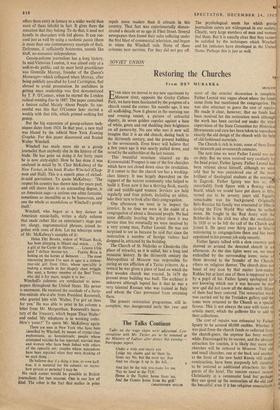SOVIET UNION
Restoring the Churches
From DEV MURARKA MOSCOW
EV ER since we moved to my new apartment by Moscow river, opposite the Gorky Culture Park, we have been fascinated by the progress of a church round the corner. Six months ago, it was all scaffolding. Now it gleams in the morning sun and evening sunset, a picture of colourful dignity, its seven golden cupolas against a base of white, green and red shedding their brightness on all passers-by. No one who sees it now will imagine that it is an old church, dating back to the thirteenth century, and the present building to the seventeenth. Even fewer will believe that a few years ago it was nearly pulled down, and saved by the authorities at the last minute.
This beautiful structure situated on the Komsomolski Prospect is one of the few churches which have not closed down since the revolution. If it comes to that the church too has a working- class history. It was largely dependent on the support of the weaver community who helped to build it. Even now it has a thriving flock, mostly old and middle-aged women. Services are held regularly and four priests, including an abbot, take their turn to look after their congregation.
One afternoon we went in to inspect the interior. In no time we were in the midst of a congregation of about a thousand people. We had some difficulty locating the priest since it was service time but eventually we were received by a very young man, Father Leonid. He was not surprised to see us because he said that since the restoration a number of foreign visitors had dropped in, attracted by the building.
The Church of St. Nicholas or Chudovka (the place of miracle), as it is called, has a long and romantic history. In the thirteenth century the Metropolitan of Moscow was responsible for curing an eye affliction of a Tartar princess. As a reward he was given a piece of land on which the first wooden church was erected. In 1679 the present stone building was built. The architect is unknown although legend has it that he was a very talented Russian who was trained in Italy and whom the Czar prevented from returning there.
The present restoration programme, still in- complete, was inaugurated early this year and
most of the exterior decoration is complete, Father Leonid was vague about where the funds
came from but mentioned the congregation. He was also reluctant to guess the cost of repairs. He made it clear, however, that no funds had been received for the restoration work although the work has been carried out under the strict supervision of the State Committee for Historical
Monuments and care has been taken to reproduce exactly the old design of the church with the help of old-fashioned materials.
The Church is rich in icons, some of them from the sixteenth and seventeenth centuries.
The next time we went Father Leonid was not on duty. But we were received very cordially by the head priest, Father Ignaty. Father Leonid had been reticent about himself, although we were told that he was considered one of the most brilliant of theological students at the seminal in Zagorsk. Father Ignaty was less so. H, remarkably fresh figure with a flowing white beard, which we would have put down as fifty, turned out to be seventy years old. Equally remarkable was his background. Originally Belo-Russian his family was evacuated to Siberia during the First World War where he settled down. He fought in the Red Army with the Bolsheviks in the civil war after the revolution. In 1920 or so he felt the call of the Church and joined it. He spent over thirty years in Siberia ministering to congregations there and has been
appointed to his present job only recently. •
Father Ignaty talked with a slow courtesy and' showed us around the deserted church in art afternoon. As the dim lights went on, we were enthralled by the surrounding icons, some of them devoted to the founder of the Church, others on religious themes. The church does not boast of any icon by that master icon-maker Rubleu but at least one of them is supposed to be by a pupil of his. Father Ignaty apologised for not knowing which one it was because he was new apd did not know all the details well. Many of them had been restored. The restoration work was carried out by the Tretiakov gallery and the icons were returned to the Church as a special favour. This is not always the case with icons of artistic merit, which the galleries like to add to their collections.
The cost of repairs was estimated by Father Ignaty to be around 60,000 roubles. Whether it was paid from the church funds or collected from the church-goers, the expense has been worth- while. Encouraged by its success, and the obvious attraction for tourists, it is likely that more old churches will be restored in Moscow. Two old and small churches, one at the back and another at the front of the new hotel Rossia still undo* construction, have been purposely left standing to be restored as additional attractions for the guests of the hotel. The tourists cannot restore Christianity in a communist land but perhaps they can speed up the restoration of the old and the beautiful, even if it has religious associations.






























 Previous page
Previous page